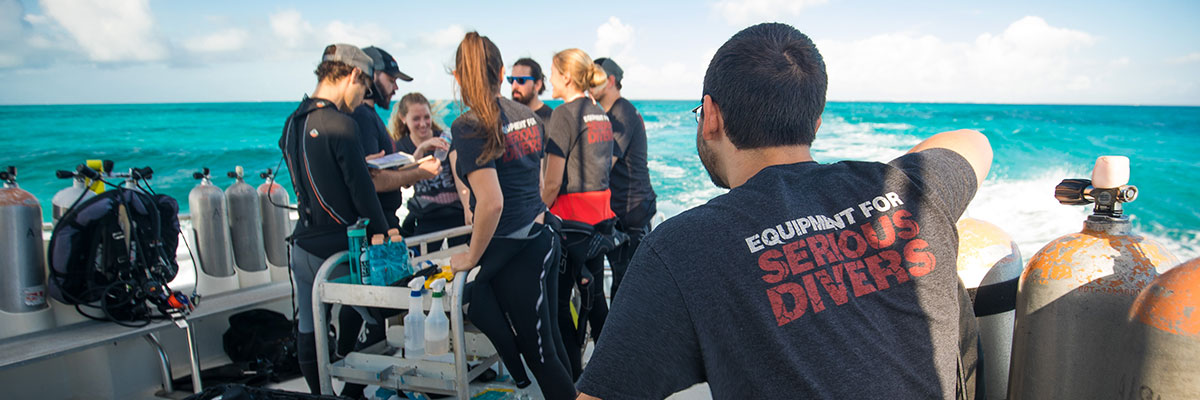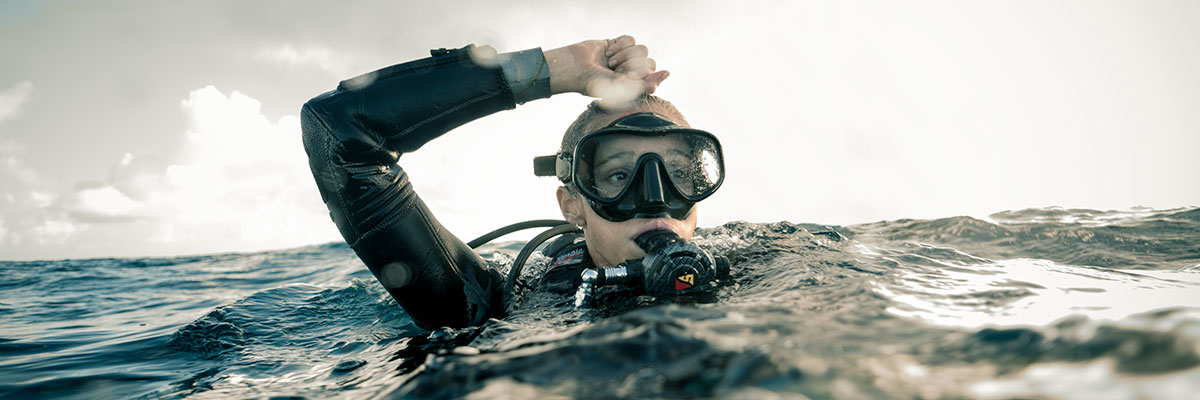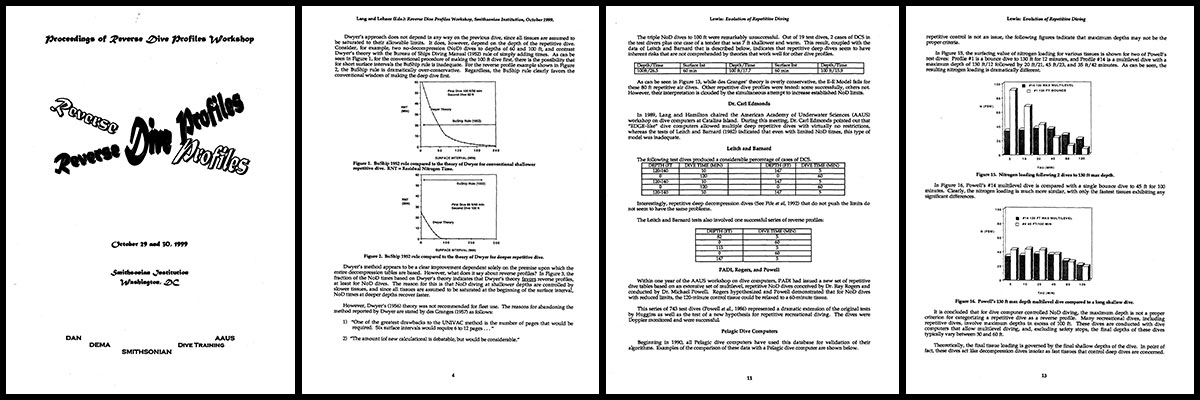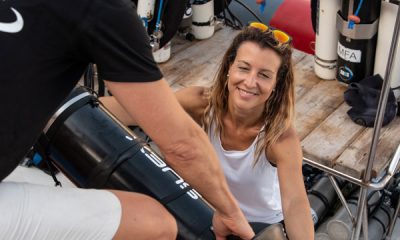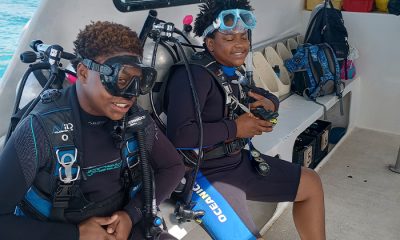Blogs
Decompression Myths: Part 3

By Mark Powell
In the [first] and [second] articles in this series I covered some myths that may have made you think about things in a slightly different way but on the whole were fairly uncontentious. This article may be a bit more contentious as the subject we are going to discuss is a topic that is regularly taught by some agencies and instructors yet has been shown to be a myth.
When I learnt to dive, I was taught there were three golden rules;
1. Never hold your breath while ascending
2. Never dive alone
3. Never dive deeper than your previous dive.
This was in the late 80s and things have moved on since then then in many ways. Equipment has changed beyond recognition and so have many training practices. SDI was launched in 1998 and just one of many firsts was the launch of a Solo Diver program which has shown the diving industry that it is possible to solo dive if you are properly trained, equipped and have the right mindset. For more detail on how the approach to solo diving has changed take a look at this [https://vimeo.com/49259855].
Equally, the idea that you should never dive deeper than your previous dive (also known as a reverse profile) has also been revisited. If you were taught that you should never dive deeper than your previous dive for safety reason in the last 5, 10 or even 20 years then that information is based on an outdated view. The reason I say up to 20 years is that the ‘revisited’ information is based on the Reverse Profile workshop that was held in 1999. In other words, this information has been available for over 20 years.
The information below is not just my view or the view of an individual training agency. The reverse diving workshop was held at the Smithsonian Institute and was organised by DAN, AAUS, DEMA and Dive Training magazine. In other words, it was a genuine scientific workshop and so its findings should be taken seriously.
These workshops are held regularly and the intention is to review key principles and to see if the scientific recommendations are still valid, or whether they need to be updated based on more recent evidence. They follow the same overall format. First the original evidence that led to the current guidance is reviewed, then any more recent evidence is reviewed and finally a recommendation is made based on the total evidence. In this case they followed the same procedure but when they came to review the evidence upon which the original recommendation was based, they made an interesting discovery. There was no scientific evidence that was originally used to create this golden rule. In tracing the background to this rule, they found the first mention of it was in an agency training manual from 1974. This manual stated that if you do the deeper dive first, and a shallower dive second, then you will get more overall dive time according to the tables. This is absolutely true, almost all tables will give the same result. However, there was no indication at this point that it was for any safety reason. Subsequent iterations of this and other training manuals gradually strengthened this statement until, eventually, it became the absolute rule that “though shall never diver deeper than your previous dive”. However, as the workshop discovered, this was never based on any scientific evidence that this was because reverse profiles were more risky than ‘normal’ profiles.
MYTH: Never dive deeper than your previous dive
Furthermore, the workshop confirmed that since the introduction of this rule there had been no subsequent research that showed an increased risk of DCS with reverse profile diving. This should not really be a surprise as many commercial, scientific and even large numbers of rogue recreational divers have been doing reverse profile dives with no apparent increased risk for many years.
In order to remove any doubt, the findings and conclusions of the workshop are reproduced below in full.
Findings:
- Historically, neither the U.S. Navy nor the commercial sector has prohibited reverse dive profiles.
- Reverse dive profiles are being performed in recreational, scientific, commercial and military diving.
- The prohibition of reverse dive profiles by recreational training organizations cannot be traced to any definite diving experience that indicates an increased risk of DCS.
- No convincing evidence that reverse dive profiles within the no decompression limits lead to a measurable increase in the risk of DCS was presented.
Conclusion:
– We find no reason for the diving communities to prohibit reverse dive profiles for no-decompression dive profiles less than 40 m/130fsw and depth differentials less than 12 m/40fsw.
If you want even more information and want to read the full details of the workshop the final report is available in full [https://repository.si.edu/handle/10088/2724].
From this we can see that there is no evidence for banning reverse profiles based on safety reasons. Of course, there may be other reasons why doing the deeper dive first may be a good idea. We have already discussed that you will get more overall No Stop Time on the tables if you do the deeper dive first. In addition, if you do a deeper dive first and use up some of you gas you can potentially do a shallower second dive while staying within safe gas limits whereas this may not be possible the other way around. Finally for divers that suffer from ear problems sometimes a deeper second dive may cause difficulties with equalisation.
However, the key point is that none of these relate to DCS risk. This is an important point because, if you remember from the first article, I said that one of my intentions is to promote a better understanding of DCS risk. If we are telling divers that there is an increased risk of DCS with reverse profile diving, when the scientific evidence says otherwise, we are reducing understanding of DCS risk rather than increasing them. You might not think this is important but I think if we have a key principle of decompression theory that instructors teach as a fundamental safety rule but science says is not true then divers may also question what other key rules are not true.
Sticking to a rule just because that is what we were first taught when the scientific evidence indicates it is not true just serves to spread misunderstanding and is exactly why myths develop. So next time you hear someone saying it’s safer to do your deepest dive first ask them what evidence they have for that.
Just in case you were wondering; the rule that you should never hold your breath while ascending is still good advice.
Blogs
Heading out on the water this Summer? Watch for manatees
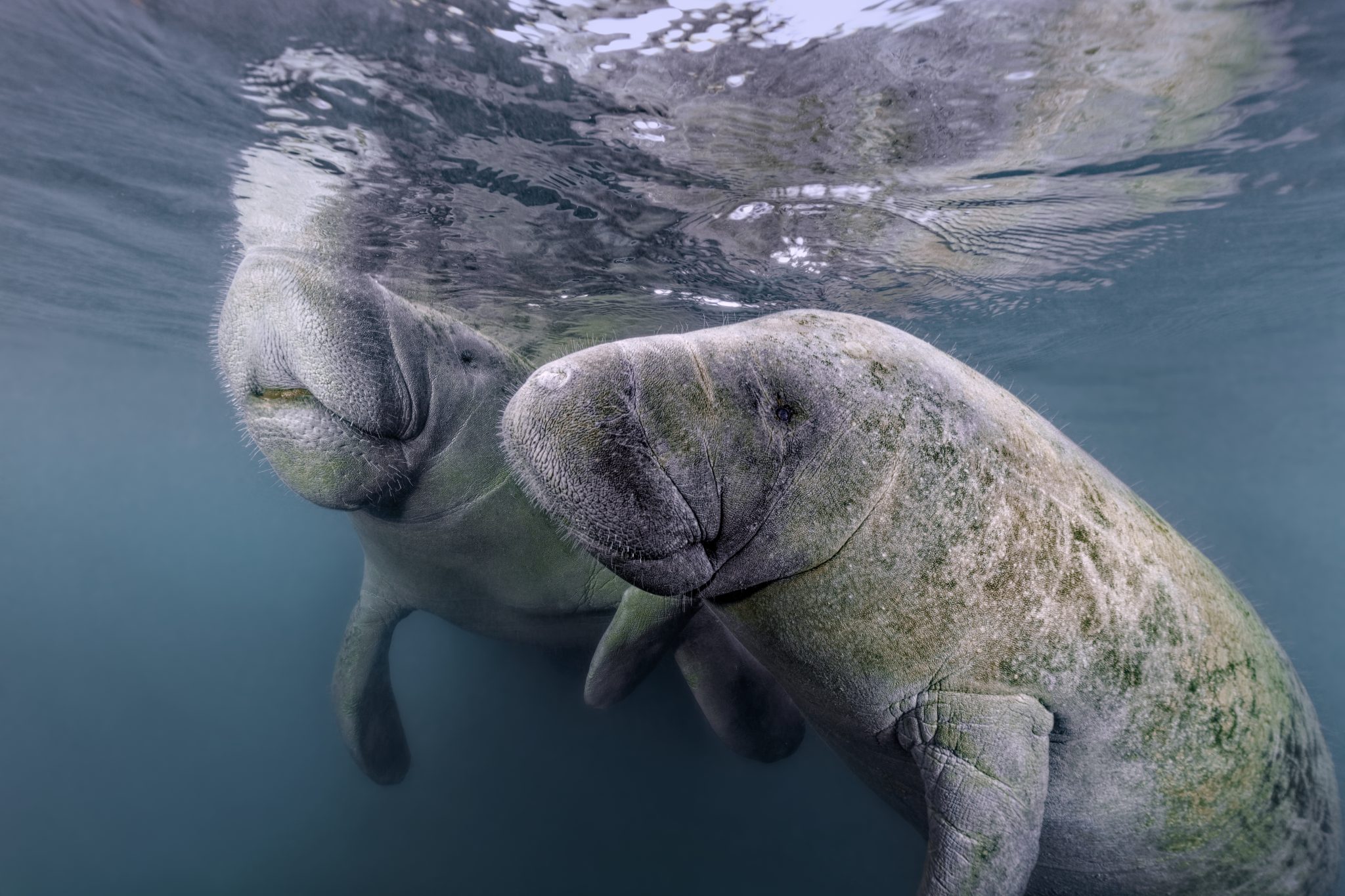
As National Safe Boating Week approaches, Save the Manatee® Club is urging boaters, and anyone that enjoys Florida’s waterways, to respect and protect the defenseless manatees that inhabit our shared waterways. From May 18 to 24, leading up to Memorial Day Weekend, the campaign aims to raise awareness about recreational boating safety and the importance of safeguarding imperiled manatees during the summer boating season. This week also emphasizes the importance of encouraging boaters to enroll in a boating safety course.
Manatees are semi-migratory marine mammals that are commonly found in shallow estuaries, bays, rivers, canals, and coastal areas throughout Florida and neighboring states. With some manatees venturing as far west as Texas and as far north as Massachusetts, collisions between these gentle giants and watercraft have become distressingly frequent. Boat propellers and high-speed collisions pose significant threats to manatees, often resulting in severe injuries or even death.
Save the Manatee Club is calling on all water enthusiasts to follow essential manatee safety tips to ensure the well-being of the imperiled manatee:
- Obey Speed Zone Signs: Familiarize yourself with and adhere to posted speed limits to prevent collisions with manatees.
- Reduce Glare with Polarized Sunglasses: Wear polarized sunglasses to enhance visibility and spot manatees below the water’s surface.
- Recognize Manatee Signs: Learn to identify signs of manatees in the area, such as swirls or flat spots on the water caused by their movements.
- Respect Manatee Sanctuaries: Keep a safe distance from posted manatee sanctuaries and avoid pursuing or harassing these marine mammals, as it is illegal and can disrupt their natural behaviors.
- Report Distressed Manatees: In Florida, promptly report distressed, injured, tagged, or orphaned manatees to the Florida Fish and Wildlife Conservation Commission (FWC) at 1-888-404-FWCC (3922). Outside of Florida, report sightings to the appropriate state agency or rescue organization. A list of agencies to contact is available at savethemanatee.org/report.
- Protect Seagrass Beds: Avoid boating over seagrass beds and shallow areas where manatees may be feeding. Stick to deep water channels while remaining vigilant, as manatees also utilize these channels during their travels.
- Dispose of Fishing Line Responsibly: Anglers should properly dispose of or recycle used fishing line to prevent entanglement hazards for manatees.
“Each year, National Safe Boating Week provides an excellent reminder for all of us to be aware that we share our waterways with vulnerable manatees,” emphasized Patrick Rose, Aquatic Biologist and Executive Director of Save the Manatee Club. “With the recent Unusual Mortality Event on Florida’s East Coast claiming an alarming number of manatees’ lives, it is more crucial than ever to prevent preventable deaths caused by watercraft collisions. By following manatee-safe boating guidelines, such as obeying speed zones and remaining vigilant for manatees, everyone on the water can contribute to the protection of these gentle giants.”
Save the Manatee Club offers a range of free materials to help safeguard manatees and raise awareness about manatee-safe boating practices. Shoreline property owners and park or marina managers can order aluminum dock signs to alert others about the presence of manatees in their areas. Boaters and paddlers can request packets containing a safety tips card, a waterproof boat banner, and a decal to display on their vessels, providing the number to report manatees in distress. To view and request these materials, visit savethemanatee.org/resources. Save the Manatee Club will also be hosting a live webinar for National Safe Boating Week on Tuesday, May 21st at 6pm EST. To register, visit savethemanatee.org/register.
Marine Life & Conservation Blogs
Book Review: Shells of the World

Shells of the World: A Natural History by M.G. Harasewych
Shells of the world is a guide to the world of marine, shelled molluscs. And what a varied and interesting world it is. Some of my favourite things to find on a dive are detailed in this book, including disco clams (or Electric File Clams as they are correctly names), the cephalopods, giant clams and sea hares. There are also many on my wish list, top of which is the Nautilus.
Each chapter provides a detailed description of the species, along with beautiful images. You can dive deeper and discover where they live, both with global distribution and the habitat they prefer. Learn about their diet, reproduction and diversity.
Having dipped in and out of this lovely book over the past few weeks, it has inspired me to learn more about this group of animals that we see on most divers, wherever we are in the world. Some of the shells are incredibly intricate and beautiful. I have always agreed with never collecting, or touching, marine life. The description of a certain set of cone shells should be a warning to those that are happy to pick up marine life! One of the cone shells has a local name called the cigarette snail. Why? Because once the venom is in your system from this animal, you only have time to smoke one cigarette before the affects of the venom are fatal!
What the publisher says:
Mollusks are invertebrate animals with a remarkable natural history and a rich fossil record, and their shells are prized for their breathtaking variety and exquisite beauty. Shells of the World provides a wide-ranging look at the incredible diversity of marine mollusks. An informative introduction outlines the lineages covered, followed by a directory section, split into classes, that profiles a broad selection of different taxa to give a sense of their sheer numbers and variety.
- Features hundreds of beautiful color photos, depicting both the live animals and their shells
- Discusses mollusk evolution, anatomy, life cycles, behavior, and ecology
- Describes unique characteristics, distribution, habitat, and size
- Provides valuable insights into the conservation of the world’s marine mollusks
- Ideal for malacologists and shell collectors everywhere
About the Author:
M. G. Harasewych is research zoologist emeritus and former curator in the Department of Invertebrate Zoology at the Smithsonian Institution’s National Museum of Natural History. A fellow of the American Association for the Advancement of Science, he is the author (with Fabio Moretzsohn) of The Book of Shells: A Life-Size Guide to Identifying and Classifying Six Hundred Seashells.
Book Details
Publisher: Princeton University Press
Hardcover
Price: £25
ISBN: 9780691248271
Published: 9th April, 2024
-

 Marine Life & Conservation Blogs3 months ago
Marine Life & Conservation Blogs3 months agoCreature Feature: Swell Sharks
-

 Gear Reviews4 weeks ago
Gear Reviews4 weeks agoGEAR REVIEW – Revolutionising Diving Comfort: The Sharkskin T2 Chillproof Suit
-

 Blogs2 months ago
Blogs2 months agoMurex Resorts: Passport to Paradise!
-

 Blogs3 months ago
Blogs3 months agoDiver Discovering Whale Skeletons Beneath Ice Judged World’s Best Underwater Photograph
-

 News3 months ago
News3 months agoPADI Teams Up with Wellness Brand Neuro to Drive Ocean Change and Create a Blue State of Mind
-

 Gear Reviews3 months ago
Gear Reviews3 months agoGear Review: Oceanic+ Dive Housing for iPhone
-

 Marine Life & Conservation2 months ago
Marine Life & Conservation2 months agoSave the Manatee Club launches brand new webcams at Silver Springs State Park, Florida
-

 Blogs2 months ago
Blogs2 months agoSeagrass Awareness Month brings critical food source for Manatees to centre stage


